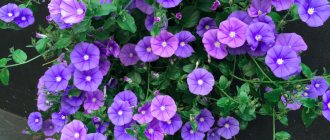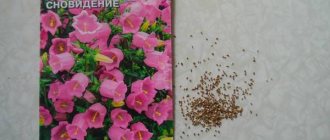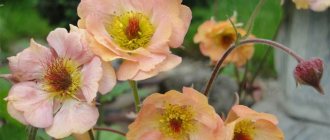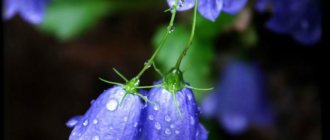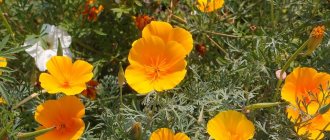Almost the entire summer period, an amazing plant with bright blue or white flowers from the bellflower family, the Carpathian bellflower, blooms in the open ground. The cultivation of numerous varieties of this plant is best achieved when planted on the southern slopes of alpine hills and in rockeries. How to take care of the plant? What are the most productive methods of propagating Carpathian bellflower? You will find answers to questions about the agricultural technology of bells in this article.
Carpathian bell: varieties and varieties
People called these cute flowers: chenilles, chebotki, bells. More than 300 species of Campanula are known. Recently, breeders have been developing new unique varieties of perennial bells suitable for planting on alpine hills.
These low perennial plants fit perfectly into landscape design
Double and non-double varieties of Carpathian bellflower, which are painted in white, pink shades and the entire spectrum of blue, have a special charm. The perennial Carpathian bell reaches only 30 cm in height; the plant's delicate stems grow anew every spring. The plant has two types of leaves: large ones are collected in a neat rosette, smaller leaves are arranged alternately on the stems. Campanula forms a lush bush, each shoot of which is crowned with single bell-shaped flowers. Flowering usually begins in mid-summer and lasts until autumn, the duration depends on the variety of bells.
Advice! Removing faded inflorescences will stimulate lateral branching and the formation of new buds. Drastic pruning of the Carpathian bellflower bush causes a second wave of plant flowering.
Varieties
The wild species is rarely grown in gardens; it is quite capricious. Varieties based on it are used for design; they are more adapted to garden conditions and grow without problems on cultivated lands. Below are several common varieties of Carpathian bellflower with descriptions and photos.
Dwarf
Gnome is a dwarf variety of the crop, no more than 15 cm in height. It is used as a ground cover plant in landscape design. Despite the short stems, the crop is capable of growing up to 50 cm in diameter. The variety is available in two petal color options – white and blue.
The Gnome variety has the longest flowering period - from early June to mid-October
Blue Clips
Blue Clips (or “blue clips”) are the most popular in ornamental gardening. It grows up to 30 cm in height, forms a dense bush, densely covered with large violet-blue flowers. Varieties with dark colors require sunny places for planting; in the shade the shade of the petals turns pale. Carpathian bell Blue Clips is often grown at home as an hanging plant. Planted in pots or portable containers. Decorate balconies or summer verandas.
Read more Growing Carpathian bell from seeds at home
The Blue Clips variety blooms in early July, the cycle lasts 60 days.
Alba
Alba is a tall plant. The main foliage is at the base of the bush, along the stem the leaves are light green, narrow, up to 1.5 cm long. The flowers are large, white, five-petaled with green staminate filaments. The plant does not require lighting; it grows in partial shade and in open areas. It does not tolerate high air humidity and loses its decorative effect in unfavorable conditions.
Alba's flowering period is 70 days starting from mid-June
Celestine
Celestine is a perennial plant 25 cm high with erect, rigid stems, along the length of which there are many buds. The flowers are large – 5–6 cm in diameter. The leaves are long-petiolate, elongated, heart-shaped, with jagged edges, and bright green. The petals are blue with a purple tint and can fade in the sun.
The Celestina bell blooms from June to September.
Isabelle
Isabel (Isabel) is a compact medium-sized bush with thin stems, the length of which is 20–25 cm. The flower of the Carpathian bell Isabel is cup-shaped, large, single. Increased foliage is observed in the lower part of the plant. The leaf blades along the stems are short and narrow. Petals are heart-shaped, light blue.
Isabel is one of the long-flowering varieties of Carpathian bellflower
The first buds open in early June, the last ones before frost.
Planting a bluebell
When planting perennial Carpathian bellflower in open ground, it is worth considering some subtleties:
- The plant can grow well in one place for more than 5 years, provided the planting site is correctly selected.
- It is best to place bluebell bushes in a sunny place. The plant can tolerate light shading, but in this case the color of the flowers fades somewhat.
Try to protect the bell from waterlogging - The bell does not tolerate stagnant water, so it is worth providing for good drainage. The ideal place for the plant is a rocky hill. Excessive water at the roots in winter causes the roots to freeze and the plant to die.
- The soil in the place where the Carpathian bell is grown should ideally have a weak alkaline reaction. Plants develop normally in soils with a neutral reaction. Before planting plants, deep digging of the soil and the introduction of humus is required, as well as agrotechnical measures to reduce soil acidity.
A bright reward for hard work - exquisite bouquets
Practice shows that planting material is considered very capricious. But don’t lose heart, just be patient and act. First of all, it is important to know when to plant Carpathian bellflower seedlings in order to successfully propagate the flower. This is the way to enjoy its flowering this year. To grow seedlings, planting material is sown in early March or late February.
It is advisable to sow seeds in open ground in mid-May in spring or early November in autumn.
First, high-quality permeable soil is prepared by mixing turf soil with humus and coarse river sand (6:3:1). The finished mixture is disinfected in a preheated oven for about 40 minutes. Some gardeners use a water bath for this purpose.
The next stage is the preparation of planting material. It is soaked in warm water for 5 hours to increase the germination of the plant.
Then they begin planting the plant, performing the following procedures:
- containers are filled with substrate;
- moisten the surface with a spray bottle;
- sowing seeds;
- Lightly press down the crops with your hand without covering them with a layer of soil;
- glass or plastic film is placed on top of the containers;
- The boxes are placed in a warm and bright room.
Before the first greenery appears, the surface of the earth is regularly moistened. If the crops are covered with glass, condensation is removed from its inner surface every day. It is enough to ventilate the film in the fresh air. The first shoots appear after about 25 days.
The temperature of the room where the crops are placed must be at least 20° C.
In order for the plant to adapt to the external environment, pinning is carried out. To do this, open the containers for 20 minutes every day. When the seedlings reach 5 cm, the cover is removed. Dense crops dive, leaving stronger options. All this time they are moistened with a sprayer. In May, when the soil warms up well, the sprouts are planted in a flowerbed or alpine hill.
As you can see, any effort is always rewarded. Various varieties of Carpathian bellflower are increasingly appearing in flower beds near country houses. Why not give yourself such a bright pleasure? It is enough to pick up the tools and act according to the established rule.
Plant care
It is not at all difficult to care for a bell in the open ground. The plant can do without watering in the spring months, when the roots receive enough moisture from melt water.
After wintering, the plants should be inspected and dead parts of the bushes should be removed.
To prevent the plant's roots from suffering from the heat, mulch the soil under the bell
During extreme heat, to retain moisture, it is necessary to mulch the soil in the beds with plants. Bluebells that grow on rocky hills do not require mulching in the summer.
Advice! Campanula does not tolerate the proximity of weeds: plant care includes timely weeding and removal of weeds from flower beds.
Is it possible to plant in open ground - care rules
Beginner gardeners often worry whether they can plant campanula outside or not? Natural species are not capricious and frost-resistant, suitable for growing in the garden and personal plot. Cultivated varieties are more demanding in care. Outdoor campanula can be planted and replanted in spring and autumn.
The soil
Campanula in open ground prefers loamy, slightly alkaline or neutral soil. Too wet soil is detrimental to the flower. If groundwater is located close to the surface, it is advisable to plant the bell on a hill.
Reducing soil acidity is quite simple; just add wood ash. Sandy soil is mixed with humus, and clay soil with sand or peat.
Feeding perennial bluebells
Feed the plant every 14 days during active flowering. Ornamental varieties need fertilizer two or three times a month. In spring, nitrogen-containing fertilizers are applied to the soil. During the budding period, mineral complex fertilizers are used. Before flowering itself, potassium or phosphate fertilizers are added to the soil. In the fall, after the inflorescences have faded, the plant is fed with potassium and superphosphate.
Important! It is forbidden to fertilize the plant with fresh manure, after which the roots begin to rot.
Loosening and weeding
In the summer, campanula at the dacha needs regular weeding. Weeds not only worsen the appearance of the site, but also harm the plant. Weeds are the habitat of many pests and insects that infect bushes and negatively affect the development of the plant. After weeding, you should water the bushes and loosen the soil under them. This process provides oxygen to the root system.
Loosening and weeding
Location and lighting
In nature, Campanula prefers well-lit places, as well as partial shade. The ideal place for planting would be the eastern or western part of the site. Direct sunlight can cause burns on the leaves. It is advisable to shade the bushes at lunchtime. In the fall, before planting the plant in the ground, the area must be dug up and organic matter added.
Pruning and wintering
After the last inflorescence has faded, the bell must be trimmed. The process removes long shoots. Then the dry inflorescences are cut off, this has a positive effect on the formation of new buds. Then mulching is carried out with peat, the root zone is insulated with dry leaves. In spring, the shelter is removed, otherwise the flower may escape. Pruning is carried out in early spring, the dried parts of the plant are removed.
Plant propagation
The Carpathian bell can be propagated by dividing the bush and seeds, which ripen in boxes by the end of September. Growing a plant from seeds is quite a troublesome task, since the seedlings are very weak and tender. When self-sowing, campanula grow in the spring adapted to local conditions. It is recommended to sow seeds in autumn or spring. Flowering specimens grown from seeds will bloom in 2-3 years.
The most convenient way to propagate bluebells is by dividing the bush.
Dividing the bush is only suitable for mature, fully grown plants that are over 3 years old.
In addition to these methods of propagation, the bell is easily propagated in the summer by green cuttings. Cuttings are cut into segments with several internodes from healthy bushes. Rooting is carried out in a greenhouse or greenhouse. Excellent results were observed when using growth stimulants during the rooting period of green cuttings. Preparations "Epin" or "Kornevin" will significantly reduce the risk of plant death and also guarantee the rapid formation of a strong root system. Grown-up specimens are transplanted to a permanent place in early autumn or spring.
Obtaining bellflower seedlings from seeds
This method is labor-intensive and time-consuming, but allows you to get good flower sprouts even in cold regions. To obtain dense seedlings, seeds are sown in small boxes (pots can be used) with substrate. Sowing is carried out from February to the end of March.
Container for growing seedlings
First you need to prepare containers for future seedlings with a certain amount of fertile soil. If it is not possible to purchase a substrate specifically for the bell, you can prepare it yourself. To do this, mix turf, organic humus and river sand.
It is important to maintain proportions. They are equal to 6:3:1 respectively. Before planting the seed, the substrate is well moistened with water.
After this, all the seeds are scattered over the surface of the substrate and lightly patted, but this should be done without sprinkling with earth. All containers are tightly covered with oilcloth or transparent glass. After this, the boxes or pots are placed in a well-heated room with natural light. The window sill of a window facing the western or southern side of the world is best suited. To prevent the seedlings from burning, you should open the boxes for a while every day for 14 days to bring in fresh air. Additionally, the soil is moistened with water at room temperature from a spray bottle.
Carpathian bellflower seedlings
The first seedlings appear in the third week. After it sprouts with leaves, they should be planted in small containers; regular yogurt or sour cream cups will do. 2-3 plants are planted in each, then observing the watering regime. Serious drying out or excessive moisture of the soil should not be allowed. In May, all seedlings can already be planted in the ground. Additional information on growing can be found in the video.
Diseases and pests
The Carpathian bellflower is practically not threatened by pests. Thin leaves and shoots of the plant suffer only from slug invasion. The preparations “Grom” and “Meta” will help to expel pests from plants.
Slugs can cause significant damage to bluebell leaves.
The leaves of bells may become rusty; preparations containing copper will help fight the disease. To prevent the spread of rust, it is useful to carry out preventive soil treatment in spring and autumn with Gumi or Fitosporin preparations.
Growing flowers from seeds
This method allows you to easily and quickly propagate elegant flowers on your site. Plants grow best in neutral, slightly alkaline soils. Flowers do not develop well in acidic soils. Therefore, clay soils are “diluted” with humus and compost at the rate of fifteen kilograms per square meter of area. If the soil is loamy, then 19 kilograms of humus are added per square meter of area.
For full growth, bells need well-lit places. Although flowers develop well in shaded areas. Bluebell "Cup and Saucer" grows beautifully under fences where soil moisture is well maintained. Therefore, it is often planted near eastern or western walls. But the flowers do not tolerate stagnant water well and in very damp areas the bells simply overheat.
Stages of growing seedlings
To quickly germinate seeds, mix turf soil, sand and humus in a ratio of 6:1:3. The soil mixture should be loose and slightly moist.
- In the last days of March, small seeds are planted in moist soil. There is no need to sprinkle the planting material with soil; you can lightly dust it with sand.
- The container with the seeds is sprayed with water, covered with film or glass and placed in a warm, dark place (air temperature approximately 20 ° C). It must be taken into account that seeds may not germinate in the light. Therefore, glass or film is covered with dark paper or thick dark material.
- Planting material germinates in 2-3 weeks. The covering layer is removed and the container is placed in a well-lit place. But you should avoid direct sunlight on the sprouts.
Caring for seedlings involves periodically irrigating the soil and carefully loosening it around the seedlings. Water the soil when its top layer dries out.
As soon as the first leaves appear on the sprouts (after approximately 3-3.5 weeks), the “Cup and Saucer” bell is picked and planted in separate containers. You can simply transplant the plants into one large box (the distance between the shoots is at least 10 cm). After another two weeks, liquid fertilizer is applied. It is recommended to combine watering and fertilizer application.
With the seedling method of propagating bells, it will be possible to admire elegant inflorescences in the form of cups and saucers already this year.
Sowing seeds in open ground
A common option for breeding bluebells is to sow planting material at a summer cottage directly into the ground. You can set aside time for this both in spring and autumn.
In the last days of October, the seeds are planted in an area protected from the winds. Only strong seeds can survive the winter, so strong seedlings appear in the spring. Already at the end of April - beginning of May, you can plant the sprouts in permanent places (beds, flower beds).
When sowing in spring, the seeds are pre-stratified (approximately two months before planting). To do this, they are kept in a solution of potassium permanganate (about an hour). Then the planting material is washed and placed on a damp cloth. To prevent the canvas from drying out quickly, place it together with the seeds in a plastic bag and put it in the refrigerator. Planting material can be planted in open ground in the second half of May.
When breeding bells in this way, it must be taken into account that in the first year of life the plants direct all their efforts to the formation of a strong root system and the development of leaf rosettes. Therefore, flowering can be expected only in the second year, when shoots with flower ovaries appear.
In order for the flowers to grow fully, they are planted at a distance of at least 30 cm from each other. To maintain soil moisture, mulch the ground between the bells.
Carpathian bellflower: combination with other plants
On an alpine hill, perennial bells are ideally combined in plantings with rock alyssum, aubrietta, lobelia, daisies and other perennial or annual plants for rocky gardens.
Bluebell looks great in a flowerbed with other perennials
The combination of blue and white bells planted side by side is very picturesque. Photos of landscape compositions using campanula confirm the ideal combination of blue bells with flowers in white, pink and yellow shades.
The plant fits perfectly with the emerald carpet of city lawns.
Description and characteristics of the plant
Campanula carpatica is native to the mountainous regions of the Carpathians and Central Europe. The perennial herbaceous plant belongs to the Campanula family. The plant grows as a compact upright bush no more than 0.4 m high. Thin stems are covered with narrow-lanceolate leaves, collected at the base into a dense rosette.
Campanula carpatica is a perennial herbaceous plant.
During flowering, which occurs in the second half of summer, the campanula is covered with delicate goblet-shaped buds with a diameter of about 50 mm. The natural color of the petals is blue, however, there are white, blue or purple varieties.
Carpathian bellflower in landscape design
In landscape design, the Carpathian bell is used for growing in rock gardens, alpine hills and rocky gardens.
Carpathian bellflower in the rock garden
In recent years, flowerpots with flowering plants have become popular in landscape design. The bell is ideal for these purposes.
Delicate flowers are planted in beds to frame paths and in mixed flower beds with low-growing plants.
Types, varieties
The Carpathian bellflower is the only species from the genus and family Campanulaceae. It has no subspecies, but experienced breeders have developed several of its varieties, differing in the color of the petals:
- lilac (Gnome);
- soft blue (Blue Numlight);
- amethyst (Torpedo, Carpathian);
- violet-blue (Blue Clips);
- white (Pearl White).
Bluebell Carpathian violet
Varieties of Carpathian bellflower: photo
Other methods of propagating garden crops
Carpathian bellflower can be propagated not only by seeds. Gardeners also practice cuttings and separation from the bush. Vegetative methods produce Campanula flowering much faster.
Cuttings
Cuttings of 3 cm are cut from an adult plant in the spring. It is important to leave 1-2 buds on them so that the campanula turns into a lush flowering bush. Planting is carried out at a temperature of +10 ° C in special containers of 3 pieces. The soil mixture should consist of earth, sand and humus.
The planted cuttings are sprinkled with sand in a layer of 2 cm. It retains water while allowing a sufficient amount of air to pass through. The seedlings are covered with a plastic bottle on top, after removing the lower leaves. Under favorable conditions, the root system of the seedling is formed within 3 weeks.
Dividing the bush
The simplest method of propagation consists in separating part of an adult flower. The procedure should be carried out in early May or late summer. The donor plant is dug up and all stems are cut off. The roots are divided into parts, which are then planted in pre-prepared planting holes. Sometimes the divided plant is grown in containers, additionally fertilized with liquid compounds.
Botanical description
Imagine a perennial plant with many thin graceful stems and fragrant funnel-shaped flowers, forming low (20-30 cm) bushes. At the roots, the leaves are rounded, collected in a rosette; ovate on stems. The flowers are solitary up to 5 cm in diameter, the calyx is open and directed upward, shaped like a bell. Botanists did not come up with a complex Latin name for this plant; they left the “bell” given by the people.
The name of the herbaceous plant “Carpathian bell” is due to its wide distribution in the mountains of Eastern and Central Europe, primarily the Carpathians. Treeless areas of Transcarpathia (the so-called meadows), densely covered with bluebells - an incomparable picture.
The plant was first described by the Austrian botanist Nikolaus Jacquen. By 1774 it had been introduced into the Royal Botanic Gardens, London's world-class botanical research center that still exists today.
Today, royal luxury is available to every gardener. The plant is unpretentious; it is enough to take into account only a few nuances.

